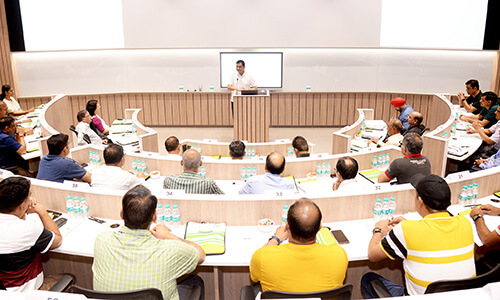GUEST 2 – DIANNA BAGNALL
Adrian, that was an ideal primer to today's show wasn't it? Where are you going to take the discussion next?
Well Ann Helena. For this interview, I’m going to jump back to one of the points I touched on in my introduction: the belief that used more effectively, and with more understanding, keeping agricultural soils healthy can help us tackle climate change. You see, the Food and Agricultural Organization of the United Nations says that nearly ten per cent of our carbon emissions could be sequestered – captured and locked-up – in agricultural soils over the next 25 years.
Ohhh everything is falling into place. Who better to help explain it than our second guest. She’s a research soil scientist from the Soil Health Institute in the USA. Welcome, Dianna Bagnall!
Hello Ann Helena, Hello Adrian
We’re glad to have you here with us – We can’t wait to hear what you have to say to Adrian. I’ll leave you in his capable hands.
Thanks Ann Helena. Dianna, atmospheric carbon dioxide levels are now 412ppm – that’s 50 per cent more than at the start of the Industrial Revolution, and we’ve seen a corresponding rise in global average temperatures. Some commentators say we’re going to have to bring those levels back down to around 350ppm if we’re to prevent the catastrophe of further warming. So the FAO’s guidance on this subject is quite significant, isn’t it?
Yes, this is a huge shift that we need to make across many sectors. How me manage soil is a part of that both because soil can emit greenhouse gasses and because it can store carbon. Most agricultural soils have lost half of the soil C they had when we started farming them. This is so critical for all the reasons Michael was just speaking about.
As a soil scientist yourself, how realistic do you think those FAO figures are? Can soils really take in that much carbon dioxide?
The capacity of soils to store carbon is significant, but it is limited. The complexity of soil across the landscape and with depth is often not well understood by most people and so it makes sense that we want to know how much C soil can store. But because the answer is so soil specific, we really need local soil carbon targets. That is something that several scientific groups acknowledge and that we at the Soil Health Institute are working on. This site specificity is something that I think we all need to be more aware of and it is why I’ve seen very believable estimates of C storage between a tenth and a half of a tonne of C per ha per year.
How exactly do soils capture carbon?
All the organic C in soil is coming from plants – from their roots, from their stems and leaves. We have to have plants and diverse plants to store soil C. And we have to leave as much of that plant reside as possible. We can sometime visualize C storage as being forever, but C is a cycle. So some C will be left in soil by plants, some will be eat by microbes and go back to the atmosphere. Think this like your bank account, the point is not that a specific dollar remains in your bank account for decades, the point is that the account is growing so that you have more money in you bank each month, even though which dollars are changing.
Can farmers do anything to influence those processes, and make the capture even more effective?
The way we store more carbon is through observing the principles of soil health. Those are to reduce disturbance like tillage, keep our soils covered, increase plant diversity, and keep living roots in our soil as much as possible. We can design practices that go in line with these principles, but they will be slightly different for different farmers and regions. Our farmers need to be able to innovate and find what works for them.
But for the farmer, it can be about more than just the money, can’t it? Isn’t it true that by implementing some of these changes, they’re making their soils healthier in the process?
There are truly mountains of data that support the idea that having more soil C in soils is a good thing. For me, the most compeling evidence is to look at our natural systems, to see that we have degreed soil C compared to that, and to use them as a reference state to tell us how good we can get. There are a lot of reasons to adopt soil health management systems, They are a true win-win-win because they are good for farmers, the environment, and society. I hear farmers talk about many benefits of soil health, including time saved they can spend with their families…
Across Europe and in North America, we’re seeing the emergence of schemes to connect farmers – carbon capturers – with those who still can’t avoid producing carbon – the emitters. How do you see this developing – what are the benefits for both parties, and of course wider society?
Talk about the way it can encourage adoption of more sustainable forms of agriculture – lo-till or no-till, which not only helps capture carbon but which also reduces losses from soil; less intensive production of crops and livestock, reducing other GHGs such as nitrous oxide and methane; added-value for farmers in being able to produce, and sell, crops that are themselves ‘low carbon’, through blockchain marketplaces such as Indigo
Carbon capture and monetization has been described by some as a ‘wild west’ – little regulation, conflicting evidence, concerns about long-term storage ability and so on. And there’s no common consensus, is there, as to how a soil carbon marketplace can work. How can we assure both farmers and emitters that these schemes do work, for soil health and socio-environmental goals?
I know that there are buyers who want to buy soil C. I know that there are farmers who want to sell soil C. To make this work, we need to get the science AND the markets right and we need to be clear on which is which. We have measure, report, and verify changes. Measuring soil C is more difficult and expensive than traditional nutrient sampling because we have to account for the density of soils as well as the concentration of C. Technologies are being developed to make this faster and cheaper (talks about DOE work). I think there are occasionally folks who want to sound the alarm about one thing or another about how we make these markets work. As an example, how long will the C be there…but we can make this work, economists know how to discount… The basic premise is that no, this is not a silver bullet, but the benefits of soil C storage are real, we achieve them through soil health, and this is a critical part of responding to climate change by drawing down C but just as importantly, it makes our food systems more resilient to Climate change.
Sounds like very much a case of ‘watch this space’. Dianna, I’m so glad you could join us today. Thank you for being with us.
Truly eye-opening, Dianna, thank you. I’ve really enjoyed listening to you and Adrian in discussion today.








